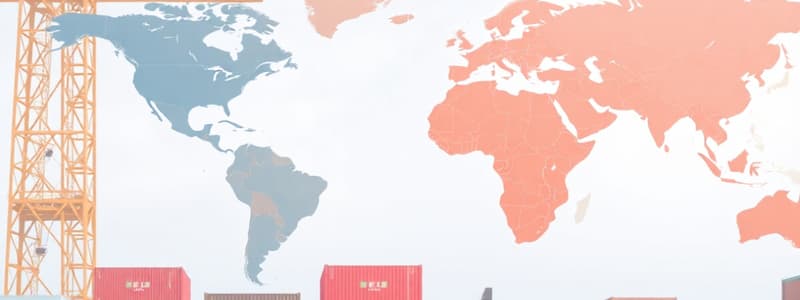Podcast
Questions and Answers
What is the primary purpose of trade liberalisation?
What is the primary purpose of trade liberalisation?
- To ease international trade through relaxation of restrictions (correct)
- To protect domestic industries from foreign competition
- To eliminate all forms of international trade
- To increase tariffs on imports
What significant agreement was created in 1947 to promote international trade?
What significant agreement was created in 1947 to promote international trade?
- General Agreement on Tariffs and Trade (GATT) (correct)
- Trade Expansion Act
- World Trade Organization (WTO)
- North American Free Trade Agreement (NAFTA)
How has trade liberalisation affected living standards in developing nations?
How has trade liberalisation affected living standards in developing nations?
- It has caused them to increase tariffs
- It has led to job losses in industrial sectors
- It has allowed greater access to international markets (correct)
- It has decreased the variety of goods available
What role does the WTO play in international trade?
What role does the WTO play in international trade?
Why do governments impose tariffs?
Why do governments impose tariffs?
What is an effect of trade liberalisation on consumers?
What is an effect of trade liberalisation on consumers?
Which country mentioned benefited significantly in its garment industry due to trade liberalisation?
Which country mentioned benefited significantly in its garment industry due to trade liberalisation?
What is a consequence of the World Trade Organization's agreements?
What is a consequence of the World Trade Organization's agreements?
What effect did GATT have on job creation?
What effect did GATT have on job creation?
What do tariffs provide for poorer countries aside from protection of domestic businesses?
What do tariffs provide for poorer countries aside from protection of domestic businesses?
Flashcards
Trade Liberalization
Trade Liberalization
Reducing barriers to international trade, such as tariffs and quotas, to encourage easier exchange of goods and services between countries.
GATT (General Agreement on Tariffs and Trade)
GATT (General Agreement on Tariffs and Trade)
An international agreement established in 1947 to reduce trade barriers and promote international trade.
WTO (World Trade Organization)
WTO (World Trade Organization)
An international organization that deals with the global rules of trade between nations.
Tariffs
Tariffs
Signup and view all the flashcards
Protectionism
Protectionism
Signup and view all the flashcards
Comparative Advantage
Comparative Advantage
Signup and view all the flashcards
Quotas
Quotas
Signup and view all the flashcards
Multilateral Trade Liberalization
Multilateral Trade Liberalization
Signup and view all the flashcards
Benefits to Consumers (Trade Liberalization)
Benefits to Consumers (Trade Liberalization)
Signup and view all the flashcards
Economic Growth (Trade Liberalization Benefits)
Economic Growth (Trade Liberalization Benefits)
Signup and view all the flashcards
Study Notes
Trade Liberalisation
- Definition: Trade liberalisation is the process of reducing tariffs and barriers to make international trade easier. It's the opposite of protectionism.
GATT (General Agreement on Tariffs and Trade)
- Creation: Established in 1947.
- Benefits: Led to increased global living standards as developing nations could export goods to industrialized countries without high tariffs.
- Impact on specific countries: China and India experienced rapid growth through GATT.
- Economic benefits: Created jobs for unskilled workers and generated between $250-$680 billion in income annually for participating countries. This benefit was particularly seen in labor-intensive industries in developing nations, due to a comparative advantage of low labor costs.
- Success story: The garment industry in India experienced significant success under GATT.
WTO (World Trade Organisation)
- Creation: Established in 1994 from GATT.
- Purpose: Reduce trade barriers, ensuring countries adhere to trade agreements.
- Dispute resolution: Addresses complaints and facilitates negotiations among member countries, leading to formal rulings.
- Trade liberalisation: Encourages trade liberalisation and provides a platform to negotiate trade disputes.
- Enforcement: Deals with disputes and ensures countries follow agreements.
Tariffs and Trade Liberalisation
- Government protectionism: Governments use tariffs, quotas, and rules to shield domestic industries from competition and imports.
- Reasons for tariffs: Include maintaining domestic industries, controlling imports of cheaper goods to protect local businesses, and generating revenue for poorer nations.
- Impact of liberalisation: Liberalization involves reducing these tariffs and quotas, making goods and services from abroad more readily available.
- Consumer benefits: Reduced costs and wider selections of goods and services.
Benefits of Trade Liberalisation
- Lower Prices: Consumers benefit from lower prices of goods because of increased competition and access to a wider range from various countries.
- Wider Variety: Access to a larger selection of quality goods and services.
- Economic growth: Increased productivity, investment, and competition can fuel economic growth.
Benefits to Businesses from Trade Liberalisation
- Diversified Risk: Trade diversifies risks and directs resources to areas with the best potential returns.
- Improved Competition/Investment: Trade openness spurs competition, attracts investment, and boosts productivity.
- Specific Industries: Particular industries in specific countries (e.g., Uganda’s coffee and other industries) benefit.
Drawbacks of Trade Liberalisation
- Increased Competition: Intensified competition can squeeze profit margins, impacting businesses.
- Job displacement: Temporary or menial jobs might be created, but overall, jobs may be displaced due to competition.
- Environmental Impact: Increased demand can lead to pollution and overuse of resources.
- Dependency: Developing nations can become economically reliant on industrialized nations.
Studying That Suits You
Use AI to generate personalized quizzes and flashcards to suit your learning preferences.




